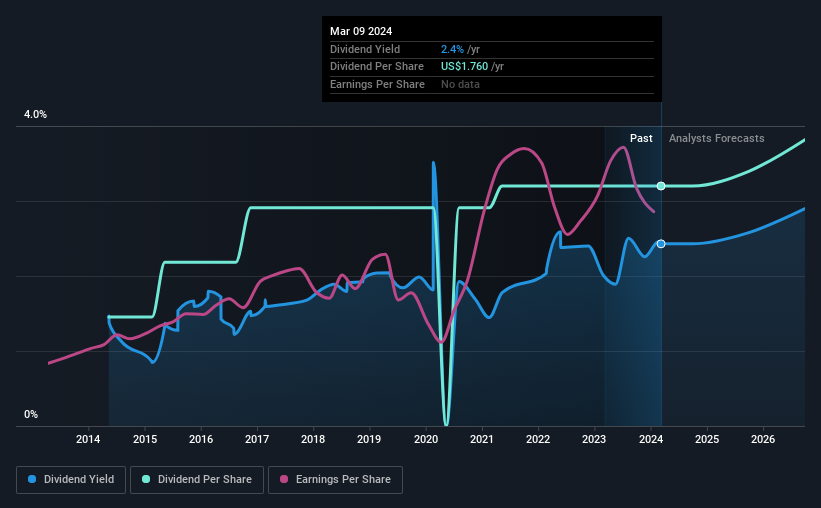There's A Lot To Like About Jack in the Box's (NASDAQ:JACK) Upcoming US$0.44 Dividend
Some investors rely on dividends for growing their wealth, and if you're one of those dividend sleuths, you might be intrigued to know that Jack in the Box Inc. (NASDAQ:JACK) is about to go ex-dividend in just 4 days. The ex-dividend date is one business day before a company's record date, which is the date on which the company determines which shareholders are entitled to receive a dividend. The ex-dividend date is of consequence because whenever a stock is bought or sold, the trade takes at least two business day to settle. Accordingly, Jack in the Box investors that purchase the stock on or after the 14th of March will not receive the dividend, which will be paid on the 27th of March.
The company's next dividend payment will be US$0.44 per share. Last year, in total, the company distributed US$1.76 to shareholders. Last year's total dividend payments show that Jack in the Box has a trailing yield of 2.4% on the current share price of US$72.46. Dividends are an important source of income to many shareholders, but the health of the business is crucial to maintaining those dividends. So we need to investigate whether Jack in the Box can afford its dividend, and if the dividend could grow.
View our latest analysis for Jack in the Box
Dividends are typically paid out of company income, so if a company pays out more than it earned, its dividend is usually at a higher risk of being cut. Fortunately Jack in the Box's payout ratio is modest, at just 31% of profit. That said, even highly profitable companies sometimes might not generate enough cash to pay the dividend, which is why we should always check if the dividend is covered by cash flow. Over the last year, it paid out more than three-quarters (88%) of its free cash flow generated, which is fairly high and may be starting to limit reinvestment in the business.
It's positive to see that Jack in the Box's dividend is covered by both profits and cash flow, since this is generally a sign that the dividend is sustainable, and a lower payout ratio usually suggests a greater margin of safety before the dividend gets cut.
Click here to see the company's payout ratio, plus analyst estimates of its future dividends.
Have Earnings And Dividends Been Growing?
Stocks in companies that generate sustainable earnings growth often make the best dividend prospects, as it is easier to lift the dividend when earnings are rising. If earnings decline and the company is forced to cut its dividend, investors could watch the value of their investment go up in smoke. Fortunately for readers, Jack in the Box's earnings per share have been growing at 10% a year for the past five years. It paid out more than three-quarters of its earnings in the last year, even though earnings per share are growing rapidly. We're surprised that management has not elected to reinvest more in the business to accelerate growth further.
Many investors will assess a company's dividend performance by evaluating how much the dividend payments have changed over time. In the past 10 years, Jack in the Box has increased its dividend at approximately 8.2% a year on average. It's encouraging to see the company lifting dividends while earnings are growing, suggesting at least some corporate interest in rewarding shareholders.
The Bottom Line
Has Jack in the Box got what it takes to maintain its dividend payments? Earnings per share have grown at a nice rate in recent times and over the last year, Jack in the Box paid out less than half its earnings and a bit over half its free cash flow. There's a lot to like about Jack in the Box, and we would prioritise taking a closer look at it.
In light of that, while Jack in the Box has an appealing dividend, it's worth knowing the risks involved with this stock. Be aware that Jack in the Box is showing 3 warning signs in our investment analysis, and 1 of those shouldn't be ignored...
Generally, we wouldn't recommend just buying the first dividend stock you see. Here's a curated list of interesting stocks that are strong dividend payers.
Have feedback on this article? Concerned about the content? Get in touch with us directly. Alternatively, email editorial-team (at) simplywallst.com.
This article by Simply Wall St is general in nature. We provide commentary based on historical data and analyst forecasts only using an unbiased methodology and our articles are not intended to be financial advice. It does not constitute a recommendation to buy or sell any stock, and does not take account of your objectives, or your financial situation. We aim to bring you long-term focused analysis driven by fundamental data. Note that our analysis may not factor in the latest price-sensitive company announcements or qualitative material. Simply Wall St has no position in any stocks mentioned.

